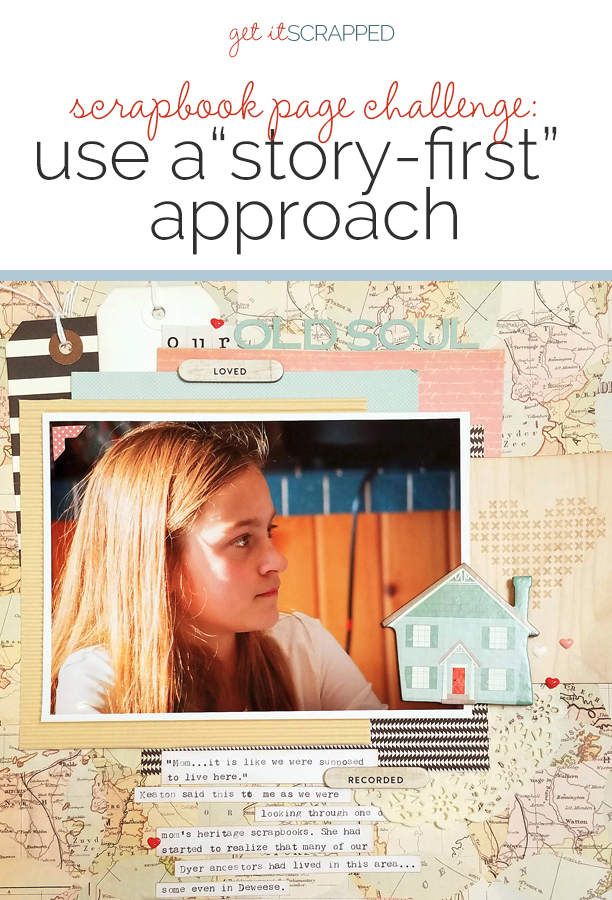 Quite often a scrapbook page comes out of the simple desire to get a story told. A “story-first” approach means you:
Quite often a scrapbook page comes out of the simple desire to get a story told. A “story-first” approach means you:
- start with your story first, writing it before you design,
- make room for the written story on the canvas right away,
- choose the right photos for that story, and
- finally, you’ll use color, motif and texture to layer meaning onto the page.
CLICK ON THE IMAGE BELOW TO SIGN UP FOR OUR EMAIL LIST AND GET YOUR FREE PAGE GUIDE
Ronnie Crowley says, “When my daughter was home for the holidays it came up that her boyfriend has said yes to something he didn’t like. It made us laugh as I had done the same early on in my relationship with my husband and I shared the story of the Mars bar. I knew had to document the story and so jotted down the basics.”
“Once I knew approximately how much text I had, I reviewed the digital templates I had looking for one that would work. I don’t often start with a story first but having written it I had a good idea of how much space I’d need for my journaling and this limited my template choices. As someone who starts with pictures first I had anticipated finding this technique harder to use, but, in the end, it worked well. Having chosen my template I knew I needed just one picture to I quickly found in the “creative commons,” a place to find photos that can be used for free. I’ll be doing this more often to record memories from the past for which I don’t have pictures.”
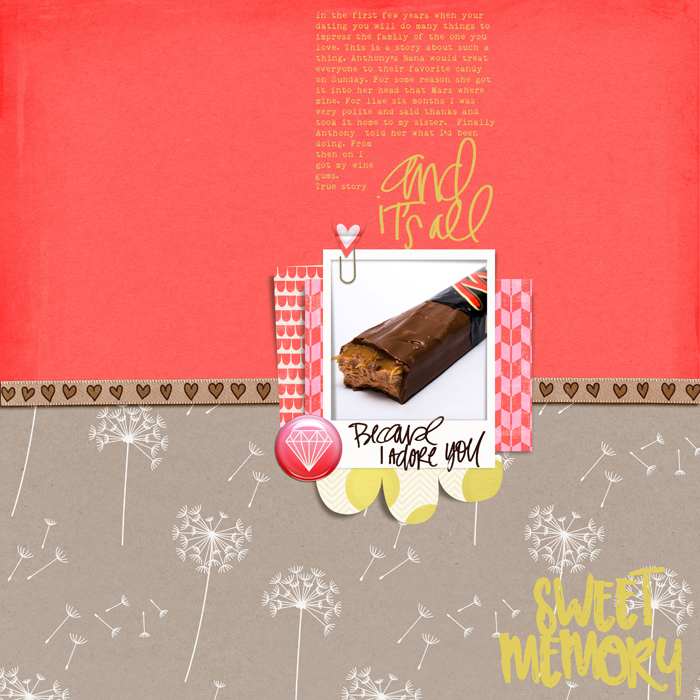
Sweet Memory by Ronnie Crowley | Supplies: Chelle Creations – Chocolate Love; Dunia Designs – This is so Me; Just Jamie- Story Starter April 2016; Karla Noell – Hey Love Stamp Sheet; River Rose – Note To Self
Kelly Sroka says, “My son joined our local fire department as a junior firefighter when he was fourteen. He was not too thrilled to be a member at first, but as he learned more about all areas of firefighting, his interest grew. After a few years he became an integral part of the station and was awarded Junior Member of the Year in 2105. Today he is studying to become a wildland firefighter.”
“I have wanted to document this story about my son for a while. Unfortunately, I do not have any photographs of the ceremony in which he was given his award. Here, I took a story-first approach. I opened up a blank document and wrote the story on my computer, not thinking yet about how I would eventually create the page. After I had the story, I went through my pictures from the last few months and found two photographs that showed my son as a firefighter. I used patterned paper and embellishments that describe my son.”
“The story-first approach is not one I use often–I usually begin with photographs. However, I have realized over the years that I have many stories that I would like to document even though I may not have pictures directly related to the stories. Creating this page took me a little longer than usual because I had to look for the pictures I wanted to use, but I am so happy to have this story documented and will definitely use this approach again.”
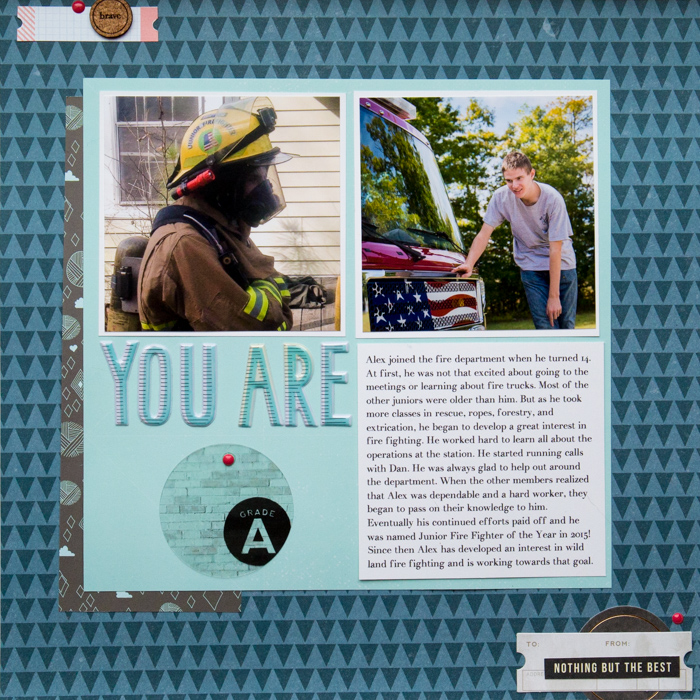
You Are by Kelly Sroka | Supplies: Patterned Paper: Crate Paper and Citrus Twist Kits; Die Cuts: Citrus Twist Kits and Pink Paislee; Letter Stickers: American Crafts; Enamel Dots and Cork Circle: Citrus Twist Kits
Jana Oliveira says, “My story is about all the changes that recently happened in my life and my one little word for the year: Embrace.”
“Once I had the story written, I knew I wanted the journaling to be as big as the picture, so they both would take center stage in the layout. I put a picture of myself parallel to the journaling so the reader knows it’s about me. I used very little embellishment to keep the story highlighted. I use this approach often when I just I want to talk through the story, often with a picture of myself. I find this approach freeing when it comes to choosing products for my page. If they don’t have much importance to the story I don’t feel I need to use them.”

My Memories by Jana Oliveira | Supplies: Jen Maddocks: Memories Kits, Kindness Kit, Artful Marks 3 masks.
Nicole Mackin says, “While my daughter and I were looking through heritage albums my mom had made, my daughter realized that a lot of our ancestors lived and settled the area that we recently moved to. She made a comment about how we were meant to live here. I used her quote as the basis for the page.”
“Story-first is an approach I don’t often use, as I mostly let photos or products guide my scrapbooking process. It was, thus, definitely challenging for me. Once I figured out what story I wanted to tell, I typed my journaling on a basic white cardstock so I would have the freedom to use it however I chose. Then I looked for a photo and products that would fit the theme of the story. I did really like this approach as I feel that there was more intention behind the layout. But as someone who fits my journaling into my almost-finished page at the end of my process, starting without design or product choice figured out was tricky for me!”
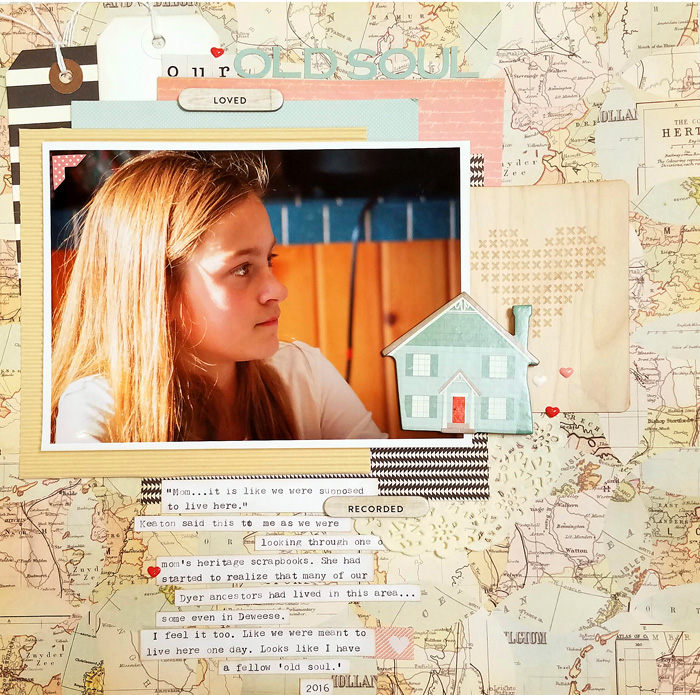
Our Old Soul by Nicole Mackin || Patterned Paper: Pink Paislee, Studio Calico, My Minds Eye; Cardstock: The Paper Studio; Corrugated Paper: DCWV; Doily: Recollections; Wood Veneer: Two Peas in a Bucket; Chipboard Stickers: American Crafts; Ink: Colorbox; Enamel Hearts; We R Memory Keepers; Letter Stickers: Carta Bella; Tags: The Paper Studio.
Kristy T. says, “This page is about how I think about things a lot, which can be good but can also be really exhausting and tends to affect my sleep, so sometimes I just wish that I could switch my brain off! I was pleased with this page, and it made my husband smile. I probably wouldn’t have made time to create it, if I hadn’t spent some time thinking about what was happening right now and what stories would I like to tell. I don’t often scrapbook about myself.”
“As I thought about my story the title of the page came to me and I knew that those words would be the main way I would tell the story. Thus, I needed a bold high-contrast title and supporting imagery. I visualized how I would represent my story, so drew the light globes around the space for the photograph and journaling within the frame. I added extra words and random dates ‘floating,’ plus simple embellishments to support the story.”
“I use a mix of approaches to my scrapbooking but it has been awhile since I started with story first. I like this approach because it means I consider more story possibilities, and that I can prioritize the stories I want to record. I generally write my journalling last and just make sure I allocate space on my pages as I create. I think for longer stories in particular, writing the journaling first would be very helpful.”

If Only I Could Switch It Off by Kristy T | Supplies: Paper: Artee; Bazzill; Pencils: Fabercastel, Prima; Watercolours: Prima; Alphas: Illustrated Faith; Sticker: Simple Stories; Tab: October Afternoon; Wooden Shape: Simple Stories; Twine: MME; Roller Stamp: Dear Lizzy American Crafts; Ink: Versafine; Chipboard Frames: Simple Stories.
Debbie Hodge says, “I started with a story of seasonal change and these photos that were snapped from my living room window over the course of one week. I’d been taking shots as the river behind our house changed dramatically in a few days — from completely iced over to melted, including coming over the banks and being a home for returning ducks. I wanted to present the sense of this quick change.”
“Here, I’ve got three photos taken on different days but within a short period of time, and 3 journaling bits to tell of these three instances. The title is a clear and descriptive label and the colors, patterns and motifs all support an outside spring-season story.”
“The process here is how many of my pages go together: I start with story, understand the page-parts needed, and then allocate space for those parts, arranging them on the page.”
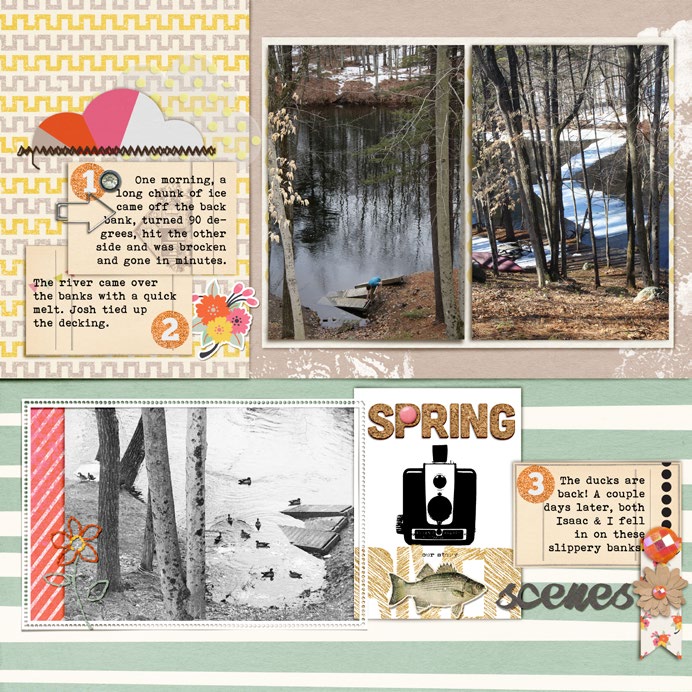
Spring River Scenes by Debbie Hodge | Supplies: Today’s Story, Shine by Laurie Ann; Giggle Snort by Sara Gleason; Postage Frames by Amy Martin; Go Fish Stickers by Katie Pertiet; Seize, Rain Rain by Allison Pennington; 5th and Frolic aby Dear Lizzie; Cork Apha Storyteller April 2014, Christmas Foil Actions, Pronuncial Alpha by Just Jaimee; Legacy by Valerie Wibbens; Half Way There by Kaye Winiecki; Color My World Journalers by Lili Niclass; The Hit, Bohemian Typewriter fonts.

